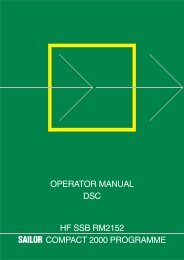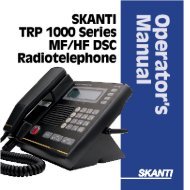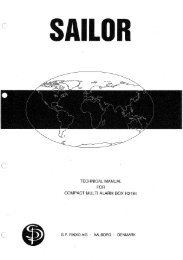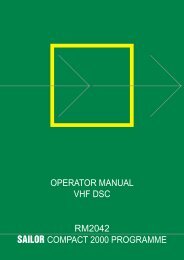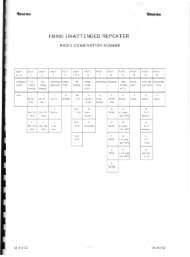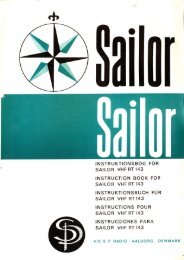CQL 632 - Storno Radio
CQL 632 - Storno Radio
CQL 632 - Storno Radio
Create successful ePaper yourself
Turn your PDF publications into a flip-book with our unique Google optimized e-Paper software.
<strong>Storno</strong><br />
secondary auxiliary winding furnishes a positive<br />
auxiliary voltagE.' for the following series regulator.<br />
S~ries Regulator<br />
The s~ri~s r~gulator consists of a series transistor<br />
Q3. a control transistor Q4. and an amplifier<br />
transistor Q5.<br />
The bas~ of the amplifier transistor receives,<br />
via an alignment potentiometer, a portioR of the<br />
stabilized output voltage. In the emitter circuit<br />
there is a reference diode, E8, and DC "oltage<br />
at this point is compared<br />
with the base voltage.<br />
The collector of the amplifier transistor connects<br />
to the base of the control transistor. If the output<br />
voltage begins to increase,<br />
so ~.ill the collector<br />
current of the amplifier transistor, and the base<br />
voltage for the control transistor will decrease.<br />
This will cause the base voltage for the series<br />
transistor<br />
to decrease and the voltage drop<br />
across the latter to increase,<br />
the output voltage to decrease.<br />
thereby causing<br />
The output voltage<br />
is adjusted for -24 volts by means of alignment<br />
potentiometer R18.<br />
In order to protect the transmitter-receiver<br />
sections against over-,,'oltage<br />
in the case of<br />
defects in the series regulator, a zener diode<br />
across the output of the regulator circuit prevents<br />
the voltage from exceeding a certain<br />
potential<br />
(approx.<br />
30 volts).<br />
<strong>Storno</strong><br />
1ff'-<br />
t!ra."lsmit r~lay ~.ill release before the antenna<br />
fhirt relay on completion of a tra!1smission.<br />
When the transmit relay is operated, the antenna<br />
I<br />
shift relay (located<br />
outside the power supply unit)<br />
is energized \ia the DC path through diode E10<br />
~d the transmit button to earth. This occurs<br />
$imultaneously with the operation of the transmit<br />
relay, but since the operating time of the antenna<br />
shift relay is sh°x:ter than that of the transmit<br />
relay,<br />
the antenna will be connected to the transmitter<br />
before the latter begins to operate and<br />
fan deliver any power. On switching to receive,<br />
~he transmit relay will be de-energized before<br />
~he antenna relay due to the fact the latter<br />
relay<br />
remains operated via contact set a3 of the trans-<br />
~it<br />
relay.<br />
Technical Specifications<br />
Supply Voltages<br />
Measured at the fuse holders.<br />
6V<br />
12 V<br />
24 V<br />
Output Voltage<br />
Regulated, -24V<br />
VoltagelMinimurnl<br />
5V<br />
10 V<br />
20 V<br />
NorninallMaxirnurn<br />
6.3 V<br />
12.6 V<br />
25.2 V<br />
7.5 V<br />
16.5 V<br />
33.0 V<br />
Output Voltage Variation<br />
For temperature and load variations.<br />
Less than % O. 6 V.<br />
Output Load<br />
Receive, max. 0.3 A<br />
Transmit, max. 1.4 A.<br />
Output Voltage<br />
Ripple-<br />
Less than 20 mV p-p.<br />
The transmit relay (ReA) is powered by thEstabilized<br />
24 -volt s'.:pply. It serves the triple<br />
purpose of switching -he supply voltage back and<br />
forth betwE-en the rec:'-"i\t:'r and tra!1s:nittt-. sections<br />
shorting a fl'edbac:k rpsi~tor in thl' DC<br />
COn\il'rt~I' un trans:'.ilt, an,j :5,'cur:nl:: that the<br />
IOperating<br />
37.561-1--:1 ,61-1':1<br />
37






